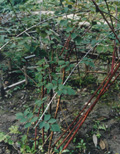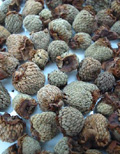|
 |
| Original plant of Fructus Rubi |
| |
 |
| Dried Fruits |
|
| Name |
Latin Name: Fructus Rubi
Common Name: Palmleaf Raspberry Fruit / Rubus Fruit
Scientific Name: Rubus Chingii Hu
Chinese Name: 覆盆子
Pinyin Name: Fu pen zi |
| Top |
|
| Origin |
| The unripe fruit of Rubus Chingii Hu; family Rosaceae.[1] |
| Top |
|
| Where Does It Grow? |
| It is mainly distributed in Zhejiang, Fujian, Hubei and Guizhou provinces of China.[1] |
| Top |
|
|
| Nature and Taste |
| It is sweet and sour in taste, slightly warm in nature and manifests its therapeutic actions in the liver and kidney meridians.[1] |
| Top |
|
| Identified Active Components/ Major Chemical Constituents[2] |
| Identified chemical constituents in Fructus Rubi include organic acids such as citric acid, malic acid and saccharides. It also contains ellgic acid, β-sitosterol and vitamin A.[2] |
| Top |
|
| Historical Use |
The Chinese name of Fructus Rubi is actually comprised of three Chinese words. The first word "Fu" (覆) means "being turned upside down". The second word "Pen" (盆) means "basin"and the third word "Zi" (子) refers to "seed". According to Bencao Gangmu (Compendium of Materia Medica) written by Dr. Li Shizhen in the Ming Dynasty, the name of the herb originated because the seed looks like a basin turned upside down. Some literature suggests the herb's name came from Fructus Rubi's ability to benefit the kidneys and reduce excessive urination. After using the herb, the urinal (basin) can be turned upside down; because, it is not needed so often.[4]
The Bencao Congxin (New Compilation of Materia Medica) describes Fructus rubi as sweet and sour with warm properties. It benefits the kidneys and consolidates essence (jing), improves impotence and reduces excessive urination as well as invigorates liver deficiency and benefits the eyes. The herb is useful for maintaining a healthy appearance and the dark color of Chinese hair. Hair is ruled by the kidneys in Chinese medicine, so hair color can be maintained if the essence contained in kidneys is sufficient.[3] |
| Top |
|
| What is It Used for in TCM? |
Fructus Rubi benefits the kidneys, consolidates essence and reduces excessive urination.[1]
| 1. |
Treatment of insufficient consolidation caused by a kidney deficiency, which manifests as involuntary discharge of semen, involuntary discharge of urine and/or urinary frequency:
Fructus Rub is sweet and sour in taste with slightly warm properties. After entering the liver and kidney meridians, the combined tastes can not only astringe (get together the lost) and consolidate the kidney essence, but also shrink or reduces the urine volume. In addition, it can invigorate both the liver (a wood element) and the kidneys (a water element). The kidneys (water) have a close mother-and-son relationship with the liver (wood). |
| 2. |
Treatment of dark vision caused by a simultaneous liver and kidney deficiency:
Fructus Psoraleae has beneficial effects on the liver and kidneys. The liver opens into the eyes so having good liver function will mean healthy eyes. Additionally, the essence of all organs in the body will pour upwards into the eyes. TCM practitioners commonly look at the eyes as a way of gauging the essence contained in the body. By consolidating essence in the kidneys, the visual functions of the eyes are benefited; because, there will be an abundance of it to pour upwards. |
|
| Top |
|
| Pharmacological Actions |
| 1. |
Estrogenic Effect |
| |
In vitro studies |
| |
Fructus Rubi was observed to have estrogenic effects on rabbit vaginal smear examinations and on vaginal endothelium smears in vitro.[5] |
|
|
| 2. |
Promote Lymphocyte Proliferation |
| |
In vitro studies |
| |
Four types of Fructus Rubi extracts: water extract, alcohol extract, crude polysaccharide extract and butanol extract, all demonstrated lymphocyte proliferation promoting effects with or without Con A stimulation.[6] |
|
|
| 3. |
Elevate Testosterone Level |
| |
Animal studies |
| |
A water extract of Fructus Rubi could act directly on rat Leydig cells (cells in the testes that secrete the hormone testosterone) to promote the activity of steroid synthesizing enzymes and to inhibit their degradation. As a consequence, more testosterone was synthesized and blood testosterone levels were elevated in the rats.[7] |
|
| Top |
| Administration and Dosage |
| A decoction is typically made with 5-10g of Fructus Rubi and three to four cups of boiling water until the volume is reduced by half.[1]A decoction is usually taken orally and split into two doses but this dose may taken all at once or escalated depending on the person's condition and recommendation by the Chinese medicine practitioner. |
| Top |
|
| Adverse Effect, Side Effects and Cautions |
| Fructus Rubi is contraindicated in individuals with difficulty starting urination or who have reduced urine volume. |
| Top |
| References |
| 1. |
雷載權主編《中藥學》上海科學技術出版社, 2000年6月。
Lui Daiquan, ed. Chinese Medicine. Shanghai Scientific and Technical Publishers, 2000-6. |
|
|
| 2. |
李家實主編《中藥鑒定學》上海科學技術出版社, 2000年2月。
Li Jiashi, ed. Chinese Medicine Identification. Shanghai Scientific and Technical Publishers, 2000-6. |
|
|
| 3. |
吳儀洛《本草從新》1757。
Wu Yiluo. Bencao Congxin (New Compilation of Materia Medica), 1757AD. |
|
|
| 4. |
李時珍《本草綱目》1578AD.
Li Shizhen, Bencao Gangmu (Compendium of Materia Medica) 1578AD. |
|
|
| 5. |
江蘇新醫學院編•中藥大辭典•下冊•上海:上海科學技術出版社,1986•2698
Jiangsu Modern Medicine College, ed. Pharmacopoeia of Chinese medicine, Volume II. Shanghai Scientific and Technical Publishers 1986?2698.* |
|
|
| 6. |
陳坤華,方軍,金虹波等•覆盆子提取物成分促進淋巴細胞增殖作用及與環核?酸的關係•上海免疫雜誌1995,15(5):302.*
Chen Kunhua, Fang Jun, Jin Hung, et al. Enhancement of Fructus Rubi extract ingredients on lymphocyte proliferation and its relationship with cyclic nucleotide. Shanghai Journal of Immunology 1995,15(5):302.* |
|
|
| 7. |
李忠主編•現代臨床中藥•北京:中國醫藥科技出版社, 1994,241.*
Li Zhong ed. Modern Clinical Chinese Medicine. Beijing: China Medical Technological Publishers 1994, p241.* |
| |
|
| * |
Quoted in "Wang BX ed. Modern Pharmacological studies on Chinese Medicine. Tianjin Scientific Technology Publishing, 1999: 1248-1250"
引述自"王本祥編•現代中藥藥理學•天津科學技術出版社, 1999: 1248-1250" |
|
| Top |
|
|
|
|